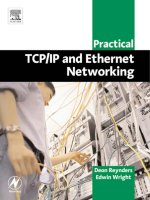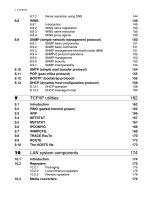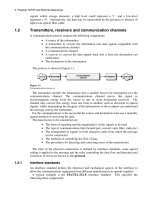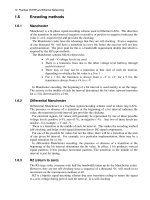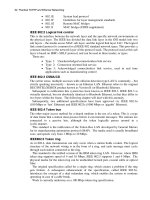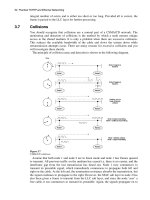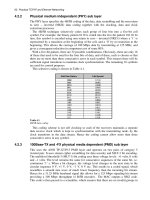Practical TCP/IP and Ethernet Networking- P21 ppt
Bạn đang xem bản rút gọn của tài liệu. Xem và tải ngay bản đầy đủ của tài liệu tại đây (544.74 KB, 10 trang )
182 Practical TCP/IP and Ethernet Networking
Figure 10.6
Fast Ethernet hub interconnection
10.6 Switches
Ethernet switches are an expansion of the concept of bridging and are, in fact, intelligent
(self-learning) multi-port bridges. They enable frame transfers to be accomplished
between any pair of devices on a network, on a per-frame basis. Only the two ports
involved ‘see’ the specific frame. Illustrated below is an example of an 8 port switch,
with 8 hosts attached. This comprises a physical star configuration, but it does not operate
as a logical bus as an ordinary hub does. Since each port on the switch represents a
separate segment with its own collision domain, it means that there are only 2 devices on
each segment, namely the host and the switch port. Hence, in this particular case, there
can be no collisions on any segment!
In the sketch below hosts 1 & 7, 3 & 5 and 4 & 8 need to communicate at a given
moment, and are connected directly for the duration of the frame transfer. For example,
host 7 sends a packet to the switch, which determines the destination address, and directs
the package to port 1 at 10 Mbps.
Figure 10.7
8-Port Ethernet switch
LAN system components 183
If host 3 wishes to communicate with host 5, the same procedure is repeated. Provided
that there are no conflicting destinations, a 16-port switch could allow 8 concurrent frame
exchanges at 10 Mbps, rendering an effective bandwidth of 80 Mbps. On top of this, the
switch could allow full-duplex operation, which would double this figure.
10.6.1 Cut-through vs store-and-forward
Switches have two basic architectures, cut-through and store-and-forward. In the past,
cut-through switches were faster because they examined the packet destination address
only before forwarding the frame to the destination segment. A store-and-forward switch,
on the other hand, accepts and analyzes the entire packet before forwarding it to its
destination. It takes more time to examine the entire packet, but it allows the switch to
catch certain packet errors and keep them from propagating through the network. The
speed of modern store-and-forward switches has caught up with cut-through switches so
that the speed difference between the two is minimal. There are also a number of hybrid
designs that mix the two architectures.
Since a store-and-forward switch buffers the frame, it can delay forwarding the frame if
there is traffic on the destination segment, thereby adhering to the CSMA/CD protocol.
In the case of a cut-through switch this is a problem, since a busy destination segment
means that the frame cannot be forwarded, yet it cannot be stored either. The solution is
to force a collision on the source segment, thereby enticing the source host to retransmit
the frame.
10.6.2 Layer 2 switches vs layer 3 switches
Layer 2 switches operate at the data link layer of the OSI model and derive their
addressing information from the destination MAC address in the Ethernet header. Layer 3
switches, on the other hand, obtain addressing information from the network layer,
namely from the destination IP address in the IP header. Layer 3 switches are used to
replace routers in LANs as they can do basic IP routing (supporting protocols such as RIP
and RIPv2) at almost ‘wire-speed’; hence they are significantly faster than routers.
10.6.3 Full-duplex switches
An additional advancement is full-duplex Ethernet where a device can simultaneously
transmit AND receive data over one Ethernet connection. This requires a different
Ethernet NIC in the host, as well as a switch that supports full-duplex. This enables two
devices to transmit and receive simultaneously via a switch. The node automatically
negotiates with the switch and uses full-duplex if both devices can support it.
Full-duplex is useful in situations where large amounts of data are to be moved around
quickly, for example between graphics workstations and file servers.
10.6.4 Switch applications
High-speed aggregation
Switches are very efficient in providing a high-speed aggregated connection to a server or
backbone. Apart from the normal lower-speed (say, 10BaseT) ports, switches have a
high-speed uplink port (100Base-TX). This port is simply another port on the switch,
accessible by all the other ports, but features a speed conversion from 10 Mbps
to 100 Mbps.
184 Practical TCP/IP and Ethernet Networking
Assume that the uplink port was connected to a file server. If all the other ports (say,
eight times 10BaseT) wanted to access the server concurrently, this would necessitate a
bandwidth of 80 Mbps in order to avoid a bottleneck and subsequent delays. With a
10BaseT uplink port this would create a serious problem. However, with a 100Base-TX
uplink there is still 20 Mbps of bandwidth to spare.
Figure 10.8
Using a switch to connect users to a server
Backbones
Switches are very effective in backbone applications, linking several LANs together as
one, yet segregating the collision domains. An example could be a switch located in the
basement of a building, linking the networks on different floors of the building. Since the
actual ‘backbone’ is contained within the switch, it is known in this application as a
‘collapsed backbone’.
Figure 10.9
Using a switch as a backbone
LAN system components 185
VLANs and deterministic Ethernet
Provided that a LAN is constructed around switches that support VLANs, individual
hosts on the physical LAN can be grouped into smaller Virtual LANs (VLANs), totally
invisible to their fellow hosts. Unfortunately, the ‘standard’ Ethernet/ IEEE802.3 header
does not contain sufficient information to identify members of each VLAN; hence, the
frame had to be modified by the insertion of a ‘tag’, between the Source MAC address
and the type/length fields. This modified frame is known as an Ethernet 802.1Q tagged
frame and is used for communication between the switches.
Figure 10.10
Virtual LANs using switches
The IEEE 802.1p committee has defined a standard for packet-based LANs that
supports layer 2 traffic prioritization in a switched LAN environment. IEEE 802.1p is part
of a larger initiative (IEEE 802.1p/Q) that adds more information to the Ethernet header
(as shown in Fig 10.11) to allow networks to support VLANs and traffic prioritization.
Figure 10.11
IEEE 802.1p/Q modified Ethernet header
186 Practical TCP/IP and Ethernet Networking
802.1p/Q adds 16 bits to the header, of which three are for a priority tag and twelve for
a VLAN ID number. This allows for eight discrete priority layers from 0 (high) to 7 (low)
that support different kinds of traffic in terms of their delay-sensitivity. Since IEEE
802.1p/Q operates at layer II, it supports prioritization for all traffic on the VLAN, both
IP and non-IP. This introduction of priority layers enables so-called deterministic
Ethernet where, instead of contending for access to a bus, a source node can pass a frame
directly to a destination node on the basis of its priority, and without risk of any
collisions.
10.7 Routers
Unlike bridges and layer 2 switches, routers operate at layer 3 of the OSI model, namely
at the network layer (or, the Internet layer of the DOD model). They therefore ignore
address information contained within the data link layer (the MAC addresses) and rather
delve deeper into each frame and extract the address information contained in the network
layer. For TCP/IP this is the IP address.
Like bridges or switches, routers appear as hosts on each network that it is connected to.
They are connected to each participating network through an NIC, each with a MAC
address as well as an IP address. Each NIC has to be assigned an IP address with the same
NetID as the network it is connected to. This IP address allocated to each network is
known as the default gateway for that network and each host on the internetwork requires
at least one default gateway (but could have more). The default gateway is the IP address
to which any host must forward a packet if it finds that the NetID of the destination and
the local NetID do not match, which implies remote delivery of the packet.
A second major difference between routers and bridges or switches is that routers will
not act autonomously but rather have to be GIVEN the frames that need to be forwarded.
A host to the designated default gateway forwards such frames.
Protocol dependency
Because routers operate at the network layer, they are used to transfer data between two
networks that have the same Internet layer protocols (such as IP) but not necessarily the
same physical or data link protocols. Routers are therefore said to be protocol dependent,
and have to be able to handle all the Internet layer protocols present on a particular
network. A network utilizing Novell Netware therefore requires routers that can
accommodate IPX (Internet packet exchange) – the network layer component of
SPX/IPX. If this network has to handle Internet access as well, it can only do this via IP,
and hence the routers will need to be upgraded to models that can handle both IPX and
IP.
Routers maintain tables of the networks that they are connected to and of the optimum
path to reach a particular network. They then redirect the message to the next router along
that path.
10.7.1 Two-port vs multi-port routers
Multi-port routers are chassis-based devices with modular construction. They can
interconnect several networks. The most common type of router is, however, a 2-port
router. Since these are invariably used to implement WANs, they connect LANs to a
‘communications cloud’; the one port will be a local LAN port e.g. 10BaseT, but the
second port will be a WAN port such as X.25.
LAN system components 187
Figure 10.12
Implementing a WAN with 2-port routers (gateways)
10.7.2 Access routers
Access routers are 2-port routers that use dial-up access rather than a permanent (e.g.
X.25) connection to connect a LAN to an ISP and hence to the ‘communications cloud’
of the Internet. Typical options are ISDN or dial-up over telephone lines, using either the
V.34 (ITU 33.6 kbps) or V.90 (ITU 56 kbps) standard. Some models allow multiple
phone lines to be used, using multilink PPP, and will automatically dial up a line when
needed or redial when a line is dropped, thereby creating a ‘virtual leased line’.
10.7.3 Border routers
Routers within an autonomous system normally communicate with each other using an
interior gateway protocol such as RIP. However, routers within an autonomous system
that also communicate with remote autonomous systems need to do that via an exterior
gateway protocol such as BGP-4. Whilst doing this, they still have to communicate with
other routers within their own autonomous system, e.g. via RIP. These routers are
referred to as border routers.
10.7.4 Routing vs bridging
It sometimes happens that a router is confronted with a layer 3 (network layer) address it
does not understand. In the case of an IP router, this may be a Novell IPX address. A
similar situation will arise in the case of NetBIOS/NetBEUI, which is non-routable. A
‘brouter’ (bridging router) will revert to a bridge if it cannot understand the layer 3
protocol, and in this way forward the packet towards its destination. Most modern routers
have this function built in.
10.8 Gateways
Gateways are network interconnection devices, not to be confused with default gateways
which are the IP addresses to which packets are forwarded for subsequent routing
(indirect delivery).
A gateway is designed to connect dissimilar networks and could operate anywhere from
layer 4 to layer 7 of the OSI model. In a worst case scenario, a gateway may be required
to decode and re-encode all seven layers of two dissimilar networks connected to either
side, for example when connecting an Ethernet network to an IBM SNA network.
Gateways thus have the highest overhead and the lowest performance of all the
internetworking devices. The gateway translates from one protocol to the other and
handles differences in physical signals, data format, and speed.
188 Practical TCP/IP and Ethernet Networking
Since gateways are, per definition, protocol converters, it so happens that a 2-port
(WAN) router could also be classified as a gateway since it has to convert both layer 1
and layer 2 on the LAN side (say, Ethernet) to layer 1 and layer 2 on the WAN side (say,
X.25). This leads to the confusing practice of referring to (WAN) routers as gateways.
10.9 Print servers
Print servers are devices, attached to the network, through which printers can be made
available to all users. Typical print servers cater for both serial and parallel printers.
Some also provide concurrent multi-protocol support, which means that they support
multiple protocols and will execute print jobs on a first-come first-served basis regardless
of the protocol used. Protocols supported could include SPX/IPX, TCP/IP,
AppleTalk/EtherTalk, NetBIOS/NetBEUI, or DEC LAT.
Figure 10.13
Print server applications
10.10 Terminal servers
Terminal servers connect multiple (typically up to 32) serial (RS-232) devices such as
system consoles, data entry terminals, bar code readers, scanners, and serial printers to a
network. They support multiple protocols such as TCP/IP, SPX/IPX, NetBIOS/NetBEUI,
AppleTalk and DEC LAT, which means that they not only can handle devices which
support different protocols, but that they can also provide protocol translation between
ports.
Figure 10.14
Terminal server applications
LAN system components 189
10.11 Thin servers
Thin servers are essentially single-channel terminal servers. They provide connectivity
between Ethernet (10BaseT/100Base-TX) and any serial devices with RS-232 or RS-485
ports. They implement the bottom 4 layers of the OSI model with Ethernet and layer 3/4
protocols such as TCP/IP, SPX/IPX and DEC LAT.
A special version, the industrial thin server, is mounted in a rugged DIN rail package. It
can be configured over one of its serial ports, and managed via TELNET or SNMP. A
software redirector package enables a user to remove a serial device such as a weigh-
bridge from its controlling computer, locate it elsewhere, then connect it via a thin server
to an Ethernet network through the nearest available hub. All this is done without
modifying any software. A software package called a port redirector makes the computer
‘think’ that it is still communicating via the weighbridge via the COM port while, in fact,
the data and control messages to the device are routed via the network.
Figure 10.15
Industrial thin server (courtesy of Lantronix)
10.12 Remote access servers
Remote access servers are devices that allow users to dial into a network via analog
telephone or ISDN. Typical remote access servers support between 1 and 32 dial-in users
via PPP or SLIP. User authentication can be done via Radius, Kerberos or SecurID.
Some offer dial-back facilities whereby the user authenticates to the server’s internal
table, after which the server dials back the user so that the cost of the connection is
carried by the network and not the remote user.
Figure 10.16
Remote access server application (courtesy of Lantronix)
190 Practical TCP/IP and Ethernet Networking
10.13 Network timeservers
Network time-servers are stand-alone devices that compute the correct local time by
means of a global positioning system (GPS) receiver, and then distribute it across the
network by means of the network time protocol (NTP).
Figure 10.17
Network timeserver application
11
The Internet
Objectives
When you have completed study of this chapter you should be able to:
• Describe briefly the origins of the Internet
• Describe the various organizations associated with the Internet
• Describe the World Wide Web and the associated tools used with it
11.1 The Internet and internet
Finally, a brief explanation of the words ‘Internet and internet’.
When referred to in lowercase, as ‘internet’, this alludes to a physical collection of
packet switching networks interconnected by gateways along with protocols that enable
the system to exist as a virtual network to exist.
If the word is used as ‘Internet’, using a capital ‘I’; this indicates a collection of
networks and gateways that use the TCP/IP suite and operates as a single cooperative
virtual network worldwide.
11.2 The objectives, background and history of TCP/IP
11.2.1 The origin of TCP and IP
The Internet was originally known as the Advanced Research Projects Agency
Network (ARPANET)) and was built by Bolt, Beranek, and Newman Inc. (BBN). This
system operated from 1969 through to 1990 and was the template, or design base for
TCP/IP, using packet switching over leased lines.
11.2.2 The history and background of TCP/IP
In the early 1960s The American Department of Defense (DoD) indicated the need for a
wide-area, cross platform communication system. To accommodate this the ARPA
